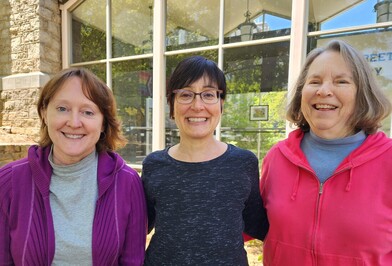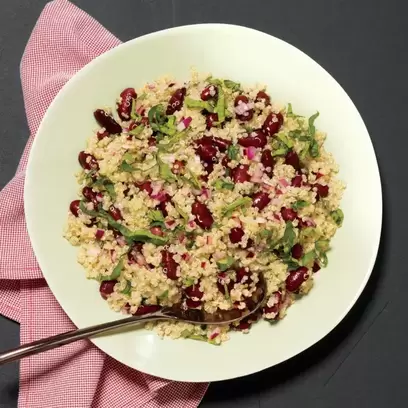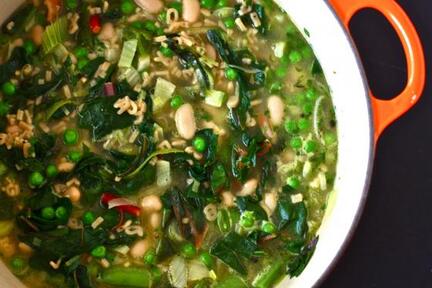Who We Are
The Health Advisory Team mission is to inspire and cultivate spiritual, physical and mental health and wholeness within ourselves, in our congregation, in our communities and in our relationship with God's beloved creation.
We strive to collaborate and partner with other ministries such as social and racial justice, mental health and the Earth team to create and share health information that supports our church's growing, alive and vibrant community.
Current areas of focus include:
We strive to collaborate and partner with other ministries such as social and racial justice, mental health and the Earth team to create and share health information that supports our church's growing, alive and vibrant community.
Current areas of focus include:
- The benefits of healthy whole foods eating
- The exploration of health, environment and social justice impacts of food and food choices
- The links between climate change, food production, environmental adaptation and health
- Information on wellness, longevity and disease prevention.
Healthy Highlights
Announcements & Upcoming Events
Friday Movie Night - August 18th
Join us to watch David Attenborough’s 2020 film A Life On Our Planet. We will meet in Rm 204 and plan to start the film at 6:30 pm.
Join us to watch David Attenborough’s 2020 film A Life On Our Planet. We will meet in Rm 204 and plan to start the film at 6:30 pm.
Farmer's Markets near you!
Asheville
Black Mountain
WNC Farmer's Market
Black Mountain
WNC Farmer's Market
Nibbles and Tidbits*
*Appears in our weekly newsletter
Hungry for more articles? Click HERE to go to the archives

NIBBLES & TIDBITS - Most Recent Newsletter Article
From your Health Advisory Team
March 14, 2023
Here at FCUCC, gathering around food at friendship-time is taken seriously. Friends and food go together—both, when done well, create physical, emotional and mental wellbeing. Healthy food, just like healthy relationships help create wholeness. One of the founding members of HAT saw a need within churches, not just FCUCC. She saw congregations pull together and support members when they are diagnosed with a disease and envisioned a ministry which could teach a new way of supporting one another. She and the healthcare professionals that made up the founding HAT ministry knew about the years of research for what is now called Lifestyle Medicine and the paradigm shift in healthcare that has come from it.
This leads me to the Blue Zones. Blue Zones are geographical locations where healthy, productive, elders happen!! Places were folks grow older rather than age. These places, all over the world, have been documented by Dan Beuttner, a National Geographic journalist. Loma Linda, CA is the only designated Blue Zone in the United States. The Seventh Day Adventists are the reason for the longevity label. Not only do they value community, but taking care of their bodies through diet and movement, is a part of their spiritual practice. Refined sugar and foods with saturated fat are very limited or simply not eaten at all. So, can other faith communities embrace change and follow the adventists lead on diet and exercise? Of course! If we made this commitment to ourselves and each other we would create a powerful and much needed force for good that ripples into the wider community and even to the natural world. Can we be open to and consider how this subject fits into our mission statement? For inspiration, we’ve included a link to a main dish Blue Zone recipe for Adventist Gumbo. The link below the recipe is an article on Brevard NC, a BLue Zone project community. Brevard is one of over 70 Blue Zone Project communities.
https://www.bluezones.com/recipe/adventist-gumbo
https://www.bluezones.com/2022/09/blue-zones-project-brevard-awarded-a-12000-grant-to-enhance-community-gardens/
Our Church Mission~
We believe God calls us to: Embody a forward-thinking, courageous, and diverse Christian community. Follow the ways of Jesus the Christ as a grace-filled, spiritual congregation. Practice affirming and radical hospitality. Engage our local and global community with acts of love, mercy, peace, and justice.
In health and wholeness,
Danna Park [email protected]
Kay Grunwald [email protected]
Mary Hawkins [email protected]
From your Health Advisory Team
March 14, 2023
Here at FCUCC, gathering around food at friendship-time is taken seriously. Friends and food go together—both, when done well, create physical, emotional and mental wellbeing. Healthy food, just like healthy relationships help create wholeness. One of the founding members of HAT saw a need within churches, not just FCUCC. She saw congregations pull together and support members when they are diagnosed with a disease and envisioned a ministry which could teach a new way of supporting one another. She and the healthcare professionals that made up the founding HAT ministry knew about the years of research for what is now called Lifestyle Medicine and the paradigm shift in healthcare that has come from it.
This leads me to the Blue Zones. Blue Zones are geographical locations where healthy, productive, elders happen!! Places were folks grow older rather than age. These places, all over the world, have been documented by Dan Beuttner, a National Geographic journalist. Loma Linda, CA is the only designated Blue Zone in the United States. The Seventh Day Adventists are the reason for the longevity label. Not only do they value community, but taking care of their bodies through diet and movement, is a part of their spiritual practice. Refined sugar and foods with saturated fat are very limited or simply not eaten at all. So, can other faith communities embrace change and follow the adventists lead on diet and exercise? Of course! If we made this commitment to ourselves and each other we would create a powerful and much needed force for good that ripples into the wider community and even to the natural world. Can we be open to and consider how this subject fits into our mission statement? For inspiration, we’ve included a link to a main dish Blue Zone recipe for Adventist Gumbo. The link below the recipe is an article on Brevard NC, a BLue Zone project community. Brevard is one of over 70 Blue Zone Project communities.
https://www.bluezones.com/recipe/adventist-gumbo
https://www.bluezones.com/2022/09/blue-zones-project-brevard-awarded-a-12000-grant-to-enhance-community-gardens/
Our Church Mission~
We believe God calls us to: Embody a forward-thinking, courageous, and diverse Christian community. Follow the ways of Jesus the Christ as a grace-filled, spiritual congregation. Practice affirming and radical hospitality. Engage our local and global community with acts of love, mercy, peace, and justice.
In health and wholeness,
Danna Park [email protected]
Kay Grunwald [email protected]
Mary Hawkins [email protected]
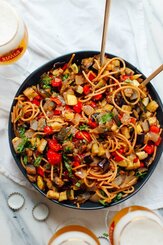
Want more vitamin C in your diet for the immune boosting benefits? Try incorporating more of the tomatoes that are becoming abundant this time of year! Here’s a recipe for Vegan Ratatouille Spaghetti- can easily use chopped fresh tomatoes instead of the cherry tomatoes depending on what’s in the garden or supermarket.
Click HERE to get the recipe!
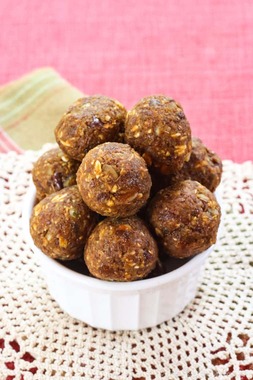
Pumpkin Spice Chocolate Chip Bites:
½ cup pumpkin puree
4 medjool dates – pitted
¼ cup pumpkin seeds
1 cup rolled oats
¼ cup hemp seeds
1 Tbs almond butter
1/3 cup chocolate chips
1 tsp pumpkin pie spice
Combine dates, almond butter, ½ of the oats in a food processor. Process until finely chopped. Transfer the mixture into a large bowl, add the remaining ingredients and mix together. Refrigerate for 1 hour, roll into balls. Store in the refrigerator. ENJOY!
½ cup pumpkin puree
4 medjool dates – pitted
¼ cup pumpkin seeds
1 cup rolled oats
¼ cup hemp seeds
1 Tbs almond butter
1/3 cup chocolate chips
1 tsp pumpkin pie spice
Combine dates, almond butter, ½ of the oats in a food processor. Process until finely chopped. Transfer the mixture into a large bowl, add the remaining ingredients and mix together. Refrigerate for 1 hour, roll into balls. Store in the refrigerator. ENJOY!
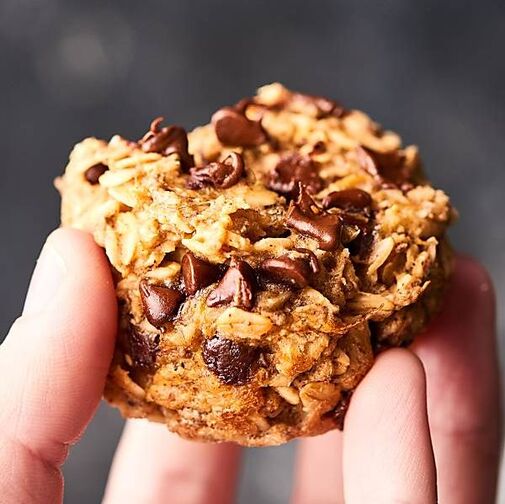
Baked Oatmeal Cups
Ingredients:
1 ½ cups of rolled oats
2 Tbs of oat flour
1 tsp of oat flour
1 Tbs of ground chia seeds
½ tsp ground cinnamon
¼ tsp baking soda
dash of sea salt
½ cup of pumpkin puree
¼ cup of pure maple syrup
1 tsp molasses
1 ½ Tbs grain-sweetened chocolate chips
1 Tbs raw pumpkin seeds
Also needed:
Muffin pan
Muffin pan paper liners
Directions:
Ingredients:
1 ½ cups of rolled oats
2 Tbs of oat flour
1 tsp of oat flour
1 Tbs of ground chia seeds
½ tsp ground cinnamon
¼ tsp baking soda
dash of sea salt
½ cup of pumpkin puree
¼ cup of pure maple syrup
1 tsp molasses
1 ½ Tbs grain-sweetened chocolate chips
1 Tbs raw pumpkin seeds
Also needed:
Muffin pan
Muffin pan paper liners
Directions:
- Preheat oven to 350 degrees. Line eight 2 1/2 -inch muffin cup with paper bake cups or use nonstick muffin cups.
- In a larger bowl stir together the first 7 ingredients (through salt). In a small bowl, combine the pumpkin puree, maple syrup and molasses. Add pumpkin mixture to flour mixture. Mix well. Add chocolate pieces and pumpkin seeds. Spoon about 1/3 of cup batter into each lined muffin cup. Use a spatula to lightly pack batter.
- Bake 20 minutes. Transfer pan to a wire rack; cool 5 minutes. Remove oatmeal cups from pan; cool completely on wire rack. Serve warm or at room temperature.
|
Stay in Touch!
Call us at (828)252-8729. Our mailing address is PO Box 3211, Asheville, NC 28802. We are physically located at 20 Oak Street in downtown Asheville. |
